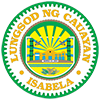
Hacienda De San Luis

In 1887, a portion of Barrio Mabantad of about 3,940 hectares, was acquired by the Compaña Casal owned by Mr. Antonio Casal for 22,000 pesos. Mr. Federico Corea was appointed as the first administrator of the hacienda. Mr. Corea, named the locality as San Luis after Saint Louis Bertrand, O.P. (1526-1581; Luis Beltrán), a Spanish Dominican who preached in South America during the 16th century, and is known as the “Apostle of the Americas”.
The population of the hacienda grew and the area was converted into a formal barrio of Cauayan. In 1909, the compaña expanded the area of the hacienda with the purchase of 19 hectares from Mrs. Engracia Maragun de Lacaste. In 1910, another 540 hectares were bought from the government (Friar Lands Estate).
The three families: the Lelina, Lardizabal, and Valdez had been fortunate to establish the first community in the hacienda. Instructions were given to heads of these pioneering families to recruit and encourage families who wish to migrate to the hacienda from the Ilocos region. As a remuneration of their efforts, these recruiters were paid in cash and given prominent positions as capataces of cabecerias when the hacienda was subdivided into districts or cabecerias for administrative purposes. Other clan resided in the barrio; the Pauig, Fariñas, Encarnacion, Factora, Albano, Mina, and Fontanilla families.
To insure efficient administration of the hacienda, San Luis was sub-divided into cabecerias. They were: Cabeceria Especial, 1, 2, 3, 4, 7, 8, 10 (called Lanna by administrator, Sr. Jose Callejas), 11, 12, 14, and 15. Each cabeceria was head by a capataz who received orders from the administrator and relayed to the people of the hacienda. The capatazes were the supervisors of the administrator and they received compensations and commissions.
In the poblasyon of San Luis (called Cabeceria Especial) stood the first administration building. However, in 1913, the edifice was razed to the ground by fire. In its place, a more spacious building was constructed. In time, when the compaña acquired enormous business footing, other big buildings were constructed. In 1923, the Catholic Church was erected. A school building was also constructed to provide the farmers’ children their elementary education with Mr. Pio Tominez as the first teacher.
The barrio of San Luis is situated along a conspicuous curve of the Cagayan River on the northeastern part of Cauayan. It is about five kilometers away from the municipal ferry at Turayong, the old river port.